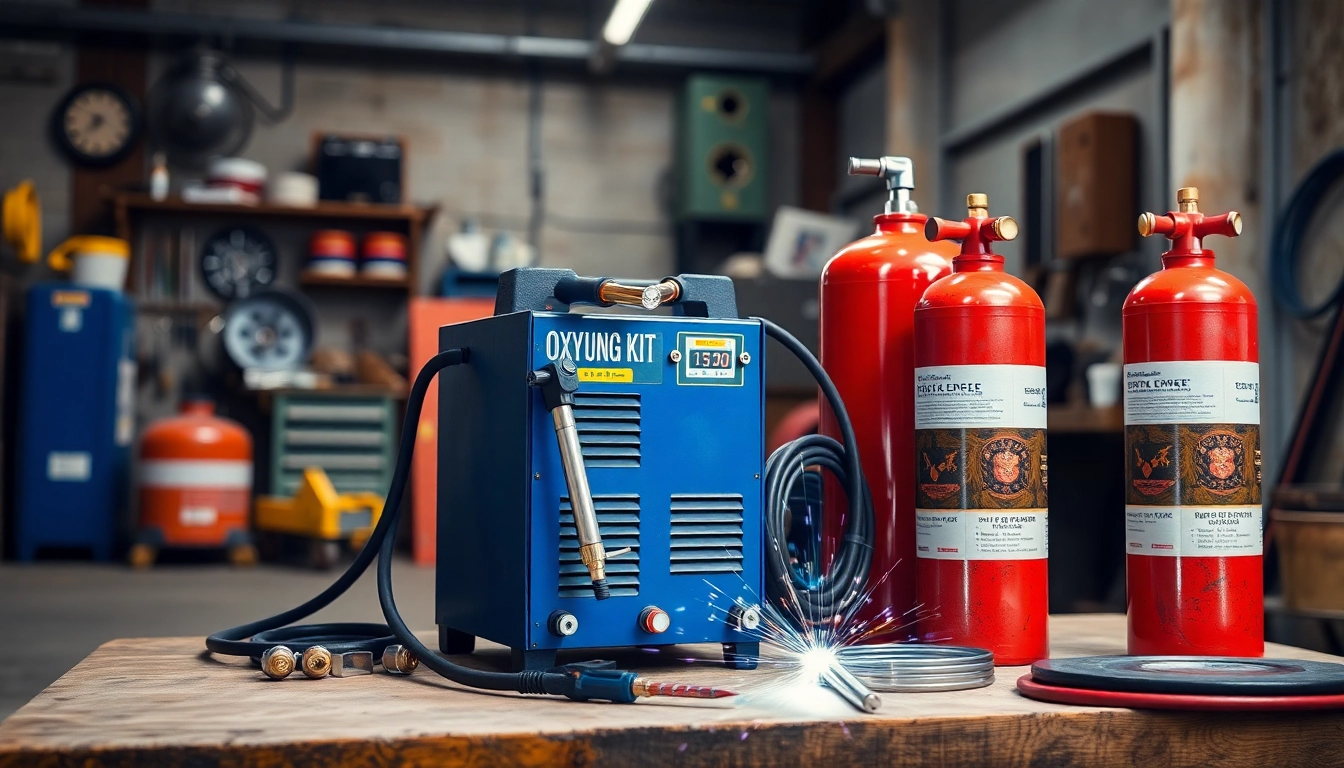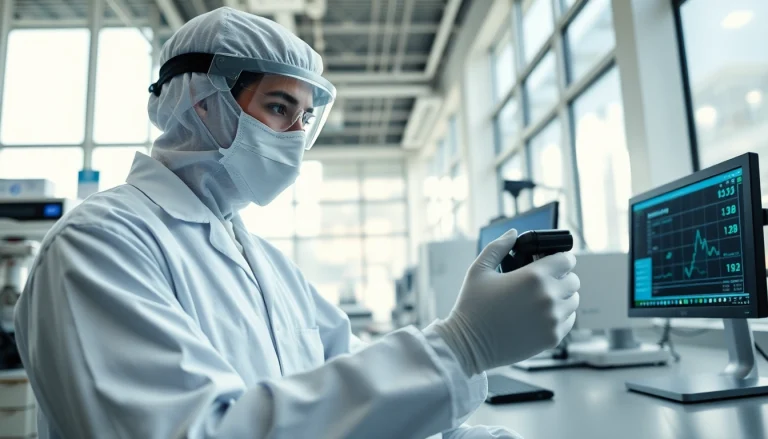1. Understanding the Oxy Gas Welding Kit
Oxy gas welding, also known as oxy-fuel welding, involves using a fuel gas and oxygen to weld and cut metals. An oxy gas welding kit is essential for anyone venturing into metal fabrication, providing all the crucial equipment in one convenient package. This kit is widely used by both hobbyists and professionals for its versatility and effectiveness in various applications, such as welding, brazing, cutting, and heating.
1.1 Components of the Oxy Gas Welding Kit
An oxy gas welding kit typically includes several vital components:
- Gas Cylinders: These are pressurized containers that hold oxygen and a fuel gas (usually acetylene). The two gases are stored separately until they are mixed at the torch.
- Welding Torch: This device mixes the fuel gas and oxygen to produce a flame for cutting or welding. The torch can be adjusted to control the flame’s intensity and temperature.
- Regulators: These control the pressure of the gases coming from the cylinders to ensure a safe and steady gas flow.
- Hoses: Flexible tubes that connect the gas cylinders to the torch, transporting the gases safely. They are often color-coded: one for oxygen (typically green) and another for acetylene (usually red).
- Nozzles: Different sizes of nozzles determine the size and shape of the flame. They are interchangeable depending on the specific welding task.
- Safety Gear: Essential gear includes gloves, goggles, and flame-resistant clothing to protect the welder from burns and harmful fumes.
1.2 How Oxy Gas Welding Works
At its core, oxy gas welding relies on a chemical reaction between oxygen and fuel gas to produce heat. When ignited, the mixture creates a high-temperature flame that can reach up to 3,500 degrees Celsius (6,332 degrees Fahrenheit). This intense heat allows the welder to melt the metal pieces together, creating a strong bond upon cooling.
The oxidation and combustion processes are facilitated by the controlled mixing of gases at the nozzle, which enables precise flame characteristics, making it suitable for various welding techniques, including:
- Welding: Fuses two metals together by melting their edges.
- Brazing: Joins metals by melting a filler rod above melting point without melting the base metals.
- Cutting: Uses the oxy-acetylene flame to preheat the metal before a jet of oxygen is applied to oxidize and blow away the molten metal.
1.3 Benefits of Using an Oxy Gas Welding Kit
Oxy gas welding offers numerous advantages that make it a preferred choice for many professionals and DIY enthusiasts:
- Versatility: Can be used for welding, cutting, and brazing on various metals, including steel, aluminum, and cast iron.
- Cost-Effective: While initial setup costs can vary, the ongoing costs for fuel are generally lower compared to other welding methods.
- Portability: The equipment can be easily transported, making it ideal for fieldwork and repairing equipment on-site.
- Skill Development: Provides ample opportunities to develop and refine welding skills, applicable in many industries.
- Precision Control: The adjustability of flame size and heat input allows for fine control during welding, which is crucial for delicate work.
2. Selecting the Right Oxy Gas Welding Kit
Choosing the right oxy gas welding kit can significantly impact your welding experience and outcomes. Here are some essential factors to consider:
2.1 Features to Look for in a Quality Kit
When assessing different oxy gas welding kits, consider the following features:
- Comprehensive Components: Ensure the kit includes essential elements like torches, regulators, and hoses, with the flexibility for upgrades.
- Safety Features: Look for kits with safety valves, pressure relief mechanisms, and high-quality hoses to minimize risks.
- Brand Reputation: Opt for kits from reliable manufacturers known for durability and performance.
- Warranty and Support: A good warranty and responsive customer support can be crucial in case of any issues with your kit.
2.2 Comparing Brands: Best Oxy Gas Welding Kits
Several brands are known for producing high-quality oxy gas welding kits, and comparing these can lead to better purchasing decisions:
- Unimig: This brand is recognized for its durable and comprehensive kits, catering to both novices and experienced welders.
- Victor: Offers trusted products with excellent performance, often leading in technological advancements.
- Harris: Their kits are known for robust design and reliability across various applications.
- Lincoln Electric: A well-established name in the welding industry, known for providing professional-grade equipment.
2.3 Price Considerations for Oxy Gas Welding Kits
Pricing can vary widely based on the kit’s quality, features, and included accessories. As of recent market insights:
- Basic kits can start at around $100, suitable for light home use.
- Mid-range kits may range from $200 to $500, often offering a more comprehensive selection of tools and features.
- High-end professional kits can exceed $1,000, equipped with advanced technology and accessories for heavy-duty industrial applications.
When budgeting, consider not only the initial purchase price but also the costs of consumables and potential future upgrades.
3. Using the Oxy Gas Welding Kit Safely
Safety is paramount when working with an oxy gas welding kit. Here are the critical aspects to ensure safe operation:
3.1 Safety Equipment and Precautions
Using the appropriate safety gear is crucial:
- Protective Goggles: Always wear goggles specifically designed for welding to protect your eyes from sparks and intense light.
- Flame-Resistant Clothing: Wear appropriate clothing that is durable and flame-resistant to avoid burns.
- Gloves: Use heat-resistant gloves to protect your hands while handling hot equipment.
- Ventilation: Ensure adequate ventilation in your workspace to avoid harmful fume buildup.
3.2 Proper Setup and Operation Techniques
Setting up your kit properly is essential:
- Check Equipment: Inspect all components for damage and ensure hoses and fittings are secure.
- Gas Regulations: Adjust the regulators to the proper pressure settings before igniting.
- Gas Leak Testing: Use soapy water to check for gas leaks at connections before igniting the torch.
- Flame Adjustment: Light the torch and adjust the flame to the desired working condition, ensuring it’s neither too rich nor too lean.
3.3 Common Mistakes and How to Avoid Them
Many common mistakes can lead to accidents or injuries, including:
- Neglecting Safety Precautions: Always prioritize safety gear, even for short jobs.
- Improper Flame Adjustment: A flame that is too small can cause metal not to melt properly, while an excessively large flame can lead to burning and wasted materials.
- Ignoring Equipment Maintenance: Regularly check and maintain your equipment to catch issues before they present safety hazards.
4. Maintenance Tips for Your Oxy Gas Welding Kit
Regular maintenance of your oxy gas welding kit is vital to ensure its longevity and safety. Here are key practices to adopt:
4.1 Cleaning and Storing Your Equipment
Proper cleaning and storage practices extend the lifespan of your kit:
- Keep Everything Clean: Regularly wipe down hoses and the welding torch with a clean cloth to remove any residue.
- Store in a Dry Place: Avoid moisture accumulation that can cause corrosion. Ideally, store your kit in a well-ventilated area away from chemicals.
- Organize Components: Ensure all pieces are stored neatly and together to prevent loss and confusion during use.
4.2 Inspecting for Wear and Tear
Frequent inspections of your equipment can help identify wear before it becomes a significant issue:
- Hoses: Look for cracks, leaks, or signs of wear. Replace any damaged hoses immediately.
- Torches and Nozzles: Inspect for clogging and ensure they are functioning correctly. Clean or replace as needed.
- Regulators: Check for proper functioning. If the gauge is reading inaccurately, it may need service or replacement.
4.3 Troubleshooting Common Issues
Being prepared for common problems can save time and frustration:
- Flame Issues: If the flame will not stay lit, check for gas flow and possible leaks in the hose or connections.
- Uneven Heating: This can often be addressed by adjusting the nozzle or verifying the flame settings.
- Regulator Malfunction: If pressure readings are inconsistent, it could be due to a faulty regulator that needs replacement.
5. Advanced Techniques with the Oxy Gas Welding Kit
Once you master the basics, you can explore advanced welding techniques that enhance your skills:
5.1 Mastering Welding Positions
Welding in different positions can significantly impact the quality of your work:
- Flat Position: Easiest for beginners, providing maximum control.
- Horizontal Position: Requires practice but allows for efficient use of gravity.
- Vertical and Overhead Positions: These are more challenging and require skilled manipulation of the torch and technique adjustment.
5.2 Special Applications for Oxy Gas Welding
Beyond general welding, oxy gas setups have specialized uses:
- Brazing: Utilizing the oxy-fuel method for brazing metals where the melted filler does not cause the base metals to melt.
- Metal Sculpting: Artists often use oxy-acetylene for sculptures and custom metalwork due to its precision and control.
- Gas Cutting: Perfecting techniques in oxy-acetylene cutting allows for clean, efficient cuts in thick materials.
5.3 Upgrading Your Oxy Gas Welding Kit
As you become more proficient, you may want to enhance your kit:
- Invest in Quality Accessories: Consider better nozzles or multiple torch attachments for different jobs.
- Upgrade to Professional Equipment: Pro models often offer advanced features and higher performance capabilities.
- Learning Resources: Take welding courses or find training videos to expand your skill set.






